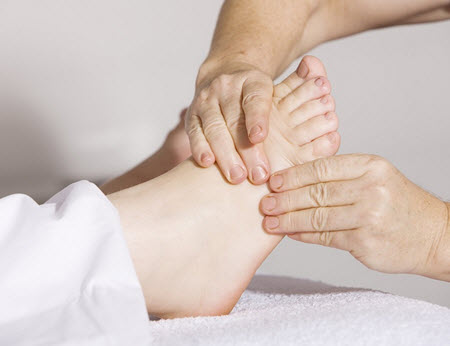Contents
Reflexology is based on the idea that specific points on the hands and feet are connected to other specific parts of the body, and that a reflexology practitioner can treat and cure various ailments by applying pressure on the right points on the hands and feet.
A very important idea within the reflexology belief system is that qi (life energy) flows through the body, that this qi can be blocked and that such blockages can prevent the body from staying healthy and properly dealing with issues. If you are familiar with traditional Chinese medicine, you will recognize a lot.
Practitioners of reflexology believe that correct pressure applied to the hands or feet can remove blockages and make qi flow well again.
The zones
In reflexology, the body is divided into ten vertical layers (zones); five to the left and five to the right. Because of this, reflexology is sometimes referred to as zone therapy.
Each organ in the human body is believed to be represented by a certain point on the hand and/or the foot. Such special points can also be found in other parts of the body, such as the ears.
Symptoms from a specific organ can thus be treated by treating its corresponding point, making the qi flow correctly again.
A treatment session
 Since only the hands or feet (sometimes also ears) are massaged, you can keep your clothes on during a treatment session, except for clothes covering those body parts.
Since only the hands or feet (sometimes also ears) are massaged, you can keep your clothes on during a treatment session, except for clothes covering those body parts.
The therapist will carefully apply pressure to certain parts of your hand/hands, foot/feet or ear/ear.
The therapist will mostly use their fingers, but sometimes other parts of the hands are used as well.
Reflexologists will normally not apply oil, skin lotion or anything else on the client’s skin before starting the treatment.
Examples of conditions that reflexology therapists usually claim to be capable of treating
- Musculoskeletal issues
- Digestive issues
- Migraines and other headaches
- Allergies
- Asthma and other issues affecting the airways
- Eczema
- Ear infections
- Sinus infections
- Urinary tract issues
- High blood pressure
- Irregular menstruation
- Painful menstruation
- Menopausal discomfort
- Sleep problems, including insomnia
- Anxiety
History
Fitzgerald
The modern version of reflexology started with the teachings of William H Fitzgerald (1872-1942) in the 1910s. Fitzgerald was an ear- nose- and throat specialists active in the USA. According to Fitzgerald, pressure applied on a certain point of the body could relieve pain at another corresponding area.
Ingham
In the 1930s and 1940s, Eunice D. Ingham (1889-1974) further developed the reflexology and also coined the name reflexology. She was a nurse and physiotherapist who proposed that hands and feet were especially sensitive and corresponding in a very special way to all the other parts of the body. She created a map over these connections and this map is still commonly used today.
Counter culture
The counter culture of the 1960s and 1970s helped to boost interest in may different alternative medicine treatments, including reflexology.
